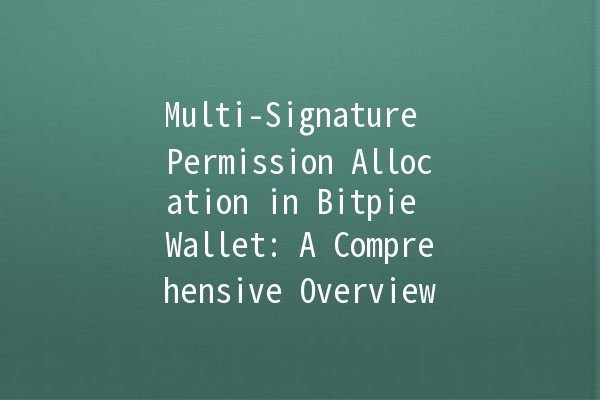
In the world of cryptocurrency, security is paramount. One innovative solution to enhance the security of crypto wallets is the implementation of multisignature (multisig) permissions. Bitpie Wallet, a popular choice among cryptocurrency enthusiasts, utilizes multisig settings to provide an extra layer of security for users. This article delves into the intricacies of multisignature permission allocation in Bitpie Wallet, offering practical tips and techniques to optimize its use.
Understanding MultiSignature Wallets
Multisignature wallets require multiple private keys to authorize a transaction. This means that even if one key is compromised, fraudulent transactions are still prevented because other keys are necessary to complete the action. Multisignature arrangements are especially beneficial for organizations, where several stakeholders need to approve transactions.
Key Features of Bitpie Wallet

Benefits of MultiSignature Allocation
Using multisignature permissions in Bitpie Wallet offers several benefits, including:
Increased Security: Requires multiple approvals for transactions.
Reduced Risk of Theft: Limits the impact of a single compromised key.
Transparent Management: Teams can collectively oversee funds, leading to better financial accountability.
Practical Tips for Effective MultiSignature Permission Allocation
Here are five essential tips to effectively allocate multisignature permissions in Bitpie Wallet:
Define who holds each private key in your multisignature setup. For example, in a business setting, you might assign:
Key Holder A: ancial Officer
Key Holder B: CEO
Key Holder C: Head of Security
Application Example: If three signatures are required for a transaction, each person should be aware of their role and the importance of safeguarding their key.
Store your private keys in a secure environment, such as a hardware wallet or a secure cloud service with encryption. Ensure that all key holders are aware of best practices for key security.
Application Example: If you opt for a hardware wallet, make sure each key holder has access to their own device and understands how to use it safely.
To streamline the process and enhance security, set transaction limits based on the key holders' levels of authority. This ensures smaller transactions don’t require unnecessary approvals, while larger ones are subjected to rigorous checks.
Application Example: The financial officer can approve transactions under $500 without needing additional signatures, whereas any amount above that requires all three keys.
Regularly review who has access to keys and adjust permissions as necessary, particularly when there are personnel changes. This can help mitigate risks associated with lost access or personnel departures.
Application Example: Conduct quarterly reviews of who holds keys and if anyone should be removed from the permission list.
Ensure that there are backup plans in place for key recovery. This could include setting up multisignature wallets with different geographical locations for key holders or having emergency contact persons to retrieve lost access.
Application Example: If one key holder loses access, a designated backup key holder can step in to help complete transactions.
Addressing Common Queries Related to MultiSignature Wallets
Multisignature wallets can be configured for a variety of signature requirements, typically anywhere from 2to3 signatures up to several more, depending on the number of stakeholders. This flexibility allows you to tailor the level of security and usability that best fits your needs.
Yes, in Bitpie Wallet, you can adjust the number of required signatures for transactions, but the process might involve creating a new multisignature setup with the desired parameters as a best practice.
If one key holder loses access, it’s crucial to have a backup strategy in place. This could involve a recovery key or another trusted individual who has been granted access to the multisignature wallet.
Multisignature setups enhance backup security because losing one key does not mean losing access to the funds. Other key holders can still authorize transactions, which ensures continued access without compromising security.
While multisignature setups are mainly used in organizational contexts, individuals can benefit from this approach as well by sharing keys among trusted family members or associates for personal wallets.
Potential risks might include complexity in management, the possibility of losing multiple keys, or reliance on cooperation from all key holders. Establishing clear communication channels and access protocols is vital.
Embracing the multisignature capabilities of Bitpie Wallet not only enhances the security of your funds but also empowers users with greater control and accountability. By implementing these practical tips and addressing common queries, you can optimize your multisignature setup for a safer cryptocurrency experience.

